|
|
ARTHROPODS:
Insects»
Spiders»
Centipedes»
Millipedes»
Sowbugs»
Harvestmen»
Mites
& Ticks»
Scorpions»
Identification
Tips»
About
the Critter Files»
Links» |
|
|
|
| |
| TAXONOMY |
KINGDOM:
Animalia | PHYLUM: Arthropoda | CLASS: Insecta | ORDER :Diptera
| FAMILY: Tabanidae (horse flies and deer flies) |
| |
| Other
Names: Tabanids |
| |
WHAT
ARE HORSE FLIES & DEER FLIES?
LIFE CYCLE
ECOLOGY
PEST STATUS
COMMON KENTUCKY HORSE FLIES
COLLECTING & PHOTOGRAPHY
HORSE FLY FACTS
MYTHS, LEGENDS, AND FOLKLORE |
| |
| WHAT
ARE HORSE FLIES & DEER FLIES? |
|
| Horse
flies and deer flies are large flies known for their painful bites,
and belong to the family Tabanidae. Most horse flies and deer
flies are at least as large as house
flies, and generally have a similar shape as house flies. Horse
flies and deer flies can be distinguished from house flies and other
flies by their unusual antennae (shown below): all horse flies and
deer flies have 3 antennal segments, with the 3rd segment long and
conspicuous. Like all flies, horse flies and deer flies have
only one pair of wings and have mouthparts adapted for sucking. |
| |
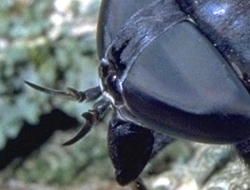 Horse
fly Antennae (R. Bessin, 2004)
Horse
fly Antennae (R. Bessin, 2004) |
| |
|
Common horse fly and deer fly species have brown, gray, or black
bodies, and most have dark-colored or patterned wings. Horsefly
and deer fly larvae are legless and resemble large maggots.
|
|
| SIZE:
Adult body length up to 1 1/8", larvae up to 1 1/2" |
| |
| LIFE
CYCLE |
|
Like
all flies, horse flies and deer flies have complete metamorphosis
with egg, larval, pupal, and adult stages. The larvae are
legless and maggot-like, and most species are found in water or
moist soil. After growing for 1-2 years (spending the winters
as larvae) the larvae pupate in spring and emerge in early
summer as winged adults. The adults usually live for only
a few days. Females of most species lay eggs on aquatic plants
that rise just above the water surface. |
| |
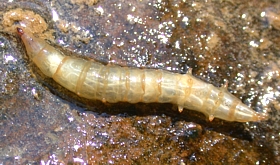 Aquatic
Horse Fly Larva (B. Newton, 2005)
Aquatic
Horse Fly Larva (B. Newton, 2005) |
| |
Adult
horse flies and deer flies are commonly found near aquatic habitats
where their larvae develop. Female horse and deer flies feed
on the blood of large mammals, including livestock and humans. Male
horse and deer flies feed only on nectar. Larval horse and
deer flies are predators, and they usually live in ponds, streams,
or moist soil. They feed on a variety of aquatic invertebrates,
including mayfly and dragonfly naiads, stonefly larvae, caddisfly
larvae, crane fly larvae, snails, and aquatic worms. Large
horse fly larvae will sometimes capture and feed on small vertebrates,
including fish and amphibians. Larvae feed by sticking their
head capsule completely inside prey and sucking fluids and internal
organs.
|
| |
| PEST
STATUS |
|
Female
horse flies and deer flies can be a serious nuisance, giving painful
bites to humans, pets, and livestock. Some people have serious
allergic reactions to the bites, and deer flies will sometimes transmit
tularemia (a bacterial disease) to rabbits, livestock, pets, and
humans. Read more about pest horse flies and deer flies in
our online factsheet: Horse
Flies & Deer Flies
|
| |
| COMMON
HORSE FLIES & DEER FLIES |
|
|
HORSE
FLIES
GENUS: Tabanus,
others
Most of horse flies found
in Kentucky belong to the genus Tabanus. Adults are typically
1/2" or larger, up to nearly 1 1/4". Most species are
mottled-gray or black. |
| |
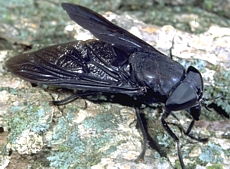 Black
Horse Fly (R. Bessin, 2004)
Black
Horse Fly (R. Bessin, 2004) |
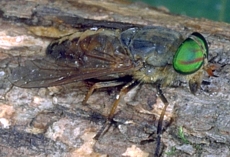 Horse
Fly (R. Bessin, 2004)
Horse
Fly (R. Bessin, 2004) |
|
|
|
DEER
FLIES
GENUS: Chrysops
Deer flies are typically
smaller (1/4" - 1/2") than horse flies and usually have
patterned wings. |
| |
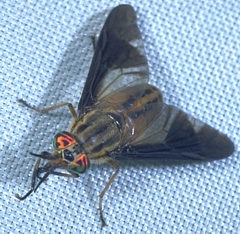 Deer fly (R.
Bessin, 2000)
Deer fly (R.
Bessin, 2000) |
|
| |
| COLLECTING
& PHOTOGRAPHY |
|
Horse
flies and deer flies are commonly found near ponds and streams during
the summer in Kentucky, especially around farms where livestock
is kept. Horse flies and deer flies are strong fliers, so
a butterfly net (also called an "aerial net") may be needed
to capture one. Larval horse flies and deer flies are common
in ponds and streams, and can be collected with aquatic insect nets.
Photographing horse flies and deer flies can be difficult,
but they will sometimes stop and rest on flowers and leaves, and
will remain still if you approach slowly with a camera.
|
| |
| HORSE
& DEER FLY FACTS |
|
Although most flies
have mouthparts adapted for sucking, female horseflies are able
to cut into flesh with their knife-like mouthparts.
Like all aquatic insects,
horse fly and deer fly larvae require clean water to live. Because
of this, scientists can tell if a stream is polluted or not based
on what types of aquatic insects are present. Read more about
using insects to determine water quality:
http://www.aces.edu/pubs/docs/A/ANR-1167/ANR-1167.pdf
|
| |
| MYTHS
- LEGENDS - FOLKLORE |
|
Do you know any myths,
legends, or folklore about horse flies or deer flies? If you
do, let us know!
|
Original document: 20 April 2005
Last updated: 20 April 2005
Photos courtesy R. Bessin and B. Newton, University of Kentucky
The Kentucky Critter
Files are maintained by Blake Newton, Department of Entomology, University
of Kentucky.
Contact: blaken@uky.edu
|
|

